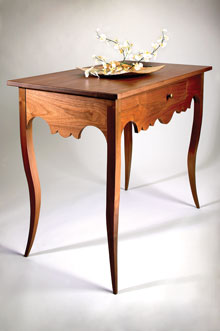We may receive a commission when you use our affiliate links. However, this does not impact our recommendations.

Coming in the February 2007 issue (at the printer now) is a close copy of an 18th-century Creole-style table I built earlier this year. It looks like an ambitious and curvy project , but that assessment would be only half-correct. While curvy, this French number is surprisingly easy.
To whet your appetite for this spicy Creole dish, we’re posting a SolidWorks drawing of the table for you to download (for free) and examine.
EDrawings is a free little program you can download (for both Mac and Windows machines), which allows you to open up the drawing file and examine the projects in extraordinary detail. And even if you have never used a CAD program, I think you’ll find this program a cinch to use.

When you open up the files you’ll see the assembled project floating in space , this is called a “live model.” And boy is it live! Using the tools at the top of the window, you can rotate this project in every direction to see all sides of it in its assembled form. You can pull individual parts off and rotate those around to look at all the joinery by zooming in and out. See how the web frame works. Make the legs transparent and zoom in on the tenons to see how they are offset from the aprons. Check out the tight dovetails (the only sure-fire way to get tight dovetails: draw them that way!)
These drawings are the next best thing to inviting you into our shop for you to examine the completed project. Heck, I think this is actually better. The projects are much easier to turn upside down and disassemble when they’re digital.
Once you see how easily this piece is put together, you might want to do some more investigation of Creole furniture. Until recently, Creole-style furniture was a bit obscure, known mostly to a handful of furniture collectors who specialized in pieces made in the Mississippi valley. But that’s changing.
The original version of this 18th-century walnut table sold for $54,625 at a 2003 auction. And other Creole pieces, such as armoires, are commanding prices up to $140,000. So what is the Creole style? Essentially, Creole encompasses furniture made in the Mississippi valley by furniture makers who were usually French-Canadian. The pieces have lots of French touches, such as cabriole legs, but also have the unmistakable restraint of early American furniture that collectors seek.

This table, for example, looks quite a bit like drawings of 18th-century French furniture from Denis Diderot’s “L’Encyclopedie ou Dictionnaire RaisonnÃ?©” (1751-1780) , but without the banding, inlay, carving and marquetry.
I first saw this table in the magazine Early American Life and was completely enamored. Our project illustrator, John Hutchinson, took a photograph and produced the construction drawings. And 37 hours of shop-time later, this is the result.
Here are some supplies and tools we find essential in our everyday work around the shop. We may receive a commission from sales referred by our links; however, we have carefully selected these products for their usefulness and quality.







That was really cool. Two questions.
1. The underside of the back of the drawer has a little upside-down step element. What is that for?
2. Are there other files like this we could look at? This is so much more helpful to me than just the static images in the magazine. Being able to rotate and hide certain parts is so incredibly useful. It would be wonderful is you could make these files avalable whenever they’re made.
Love the blog. Everyone has to start somewhere I think it’s a great idea.
Andrew
Devoted PopWood reader
You are correct Ray. Edrawings is the "freebie" offered on the Solidworks website.
Cheers,
Louis
I use SolidWorks to design most of my home projects (fortunately I have free access to a seat), but was the mis-naming intentional? The ‘free little program you can download’ is eDrawings, not SolidWorks; SolidWorks is anything but free or little…
Otherwise, keep up the good work!
Hey,I like that approach/view.It could be handy coupled with drawing.good idea.